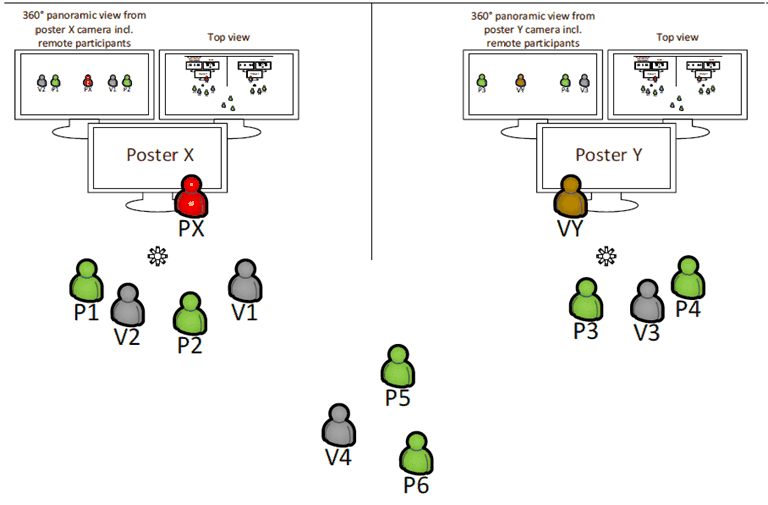Content for TR 26.928 Word version: 18.0.0
0…
4…
4.1.2…
4.2…
4.3…
4.4…
4.5…
4.6…
4.6.7
4.7…
4.9…
5…
6…
7…
8
A…
A.4…
A.7…
A.10…
A.13
A.14
A.15
A.16
A.17
A.18…
A.17 Use Case 16: Convention / Poster Session p. 114
| Use Case Name |
|---|
| Convention / Poster Session |
| Description |
This use case is exemplified with a conference with poster session that offers virtual participation from a remote location.
It is assumed that the poster session may be real, however, to contribute to meeting climate goals, the conference organizers are offering a green participation option. This is, a virtual attendance option is offered to participants and presenters, as an ecological alternative avoiding travelling.
The conference space is organized in a few poster booths, possibly separated by some shields. In some of the booths, posters are presented by real presenters, in some other booths, posters are presented by remote presenters. The audience of the poster presentations may be a mix of physically present and remote participants. Each booth is equipped with a first video screen for the poster display and one or two additional video screens for the display of a "Top view" and/or the display of a panoramic "Poster presentation view". Each booth is further equipped with a 360-degree camera system capturing the scene next to the poster. The conference space is visualized in the following Figure, which essentially corresponds to the "Top view". In this Figure, P1-P6 represent physical attendees, V1-V4 are remote attendees, PX and VY are real and, respectively, remote presenters. There are two poster presentations of posters X and Y. Participants V4, P5 and P6 are standing together for a chat.

Physical attendees and presenters have the experience of an almost conventional poster conference, with the difference that they see remote persons through their AR glasses, represented as avatars. They hear the remote persons through their binaural playback systems. They can also interact in discussions with remote persons like they were physically present. Physical presenters use a digital pointing device to highlight the parts of their poster that they want to explain. The physical audience attends the poster presentation of a remote presenter in some dedicated physical spots of the conference area that is very similar to the poster booth of a physical presenter. The participants see and hear the virtual presenter through their AR glasses supporting binaural playback. They also see and hear the other audience that may be physically present or just be represented though avatars.
Remote participants are equipped with HMD supporting binaural playback. They are virtually present and can walk from poster to poster. They can listen to ongoing poster presentations and move closer to a presentation if they think the topic or the ongoing discussion is interesting. A remote participant can speak to other participant in his/her immediate proximity and obtain a spatial rendering of what the other participants in his/her immediate proximity are saying. He/she can hear them from the relative positions they have to him/her in the virtual world. Consistent with the auditory scene, the remote participant will be able to see on the HMD a synthesized "Scene view" of the complete conference space (including the posters) from his/her viewpoint, i.e. relative to position and viewing direction. The remote participant may also select to see a "Top view", which is an overview of the complete conference space with all participants (or their avatars) and posters or to see a "Poster presentation view". The latter is a VR view generated from the 360-degree video capture at the relevant poster but excluding a segment containing the remote participant itself. The audio experience remains in any case as during "Scene view". In order to give the remote participants the possibility to interact in the poster discussions, they also have the possibility to use their VR controller as a pointing device to highlight certain parts of the poster, for instance when they have a specific question.
Remote presenters are equipped with HMD supporting binaural playback and a VR controller. Most relevant for them is the "Scene view" in which they see (in their proximity) their audience represented by avatars. This view is overlaid with their own poster. They use their VR controller as a pointing device to highlight a part of the poster that they want to explain to the audience. It may happen that a remote presenter sees some colleague passing by and, to attract her/him to the poster, they may take some steps towards that colleague and call out to her/him.
The remote participants are represented at the real event through their avatars, which the real participants and presenters see and hear through their AR glasses supporting binaural playback. The real and virtual participants and the presenter interact in discussions as if everybody was physically present.
|
| Categorization |
|
Type:
AR, VR, XR
Degrees of Freedom:
6DoF
Delivery:
Interactive, Conversational
Device:
Phone, HMD with binaural playback support, AR Glasses with binaural playback support, VR controller/pointing device
|
| Preconditions |
On a general level the assumption is all physical attendees (inside the conference facilities) wear a device capable of binaural playback. Remote participants are equipped with HMD supporting binaural playback. The meeting facility is a large conference room with a number of spatially separated booths for the different poster presentations. Each of these spots is equipped with a video screen for the poster and at least one other video screen. At each of the poster spots a 360-degree camera system is installed.
Specific minimum preconditions
|
| Requirements and QoS/QoE Considerations |
QoS: conversational requirements as for MTSI, using RTP for Audio and Video transport.
|
| Feasibility |
Under "Preconditions" the minimum preconditions are detailed and broken down by all involved nodes of the service, such as remote participants, physical participants, meeting facilities and conference call server. In summary, the following capabilities and technologies are required:
|
| Potential Standardization Status and Needs |
|